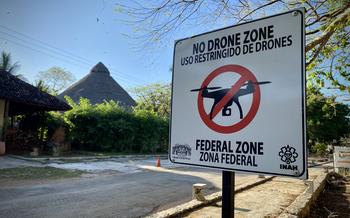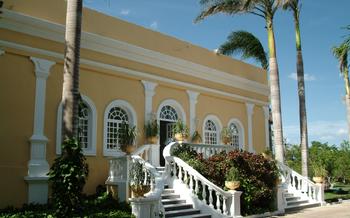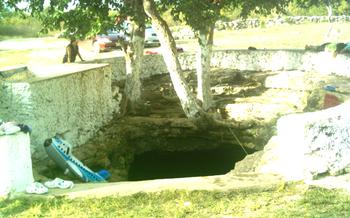
Eco Museum of Cacao in Ticul
- A Cacao Journey:
- Interactive Exhibits
- Cacao Plantation Tour
- Chocolate Tasting:
- Cacao Nursery
- Sustainable Cacao Practices
- Interactive Games and Activities
- Cacao Art and Crafts
- Cultural Performances
- Local Cuisine
- Storytelling Sessions
- Workshops
- Educational Programs:
- Community Involvement:
- Insider Tip:
A Cacao Journey:
In the heart of Ticul, nestled amidst lush greenery, lies the Eco Museum of Cacao, a sanctuary dedicated to preserving the rich legacy of cacao cultivation in the region. Step into this immersive museum, and embark on a journey through time, where you'll unravel the captivating history of cacao, its profound cultural significance in Mayan civilization, and its pivotal role in the local economy. Discover how this ancient crop, revered for its divine properties, has woven its way into the fabric of Mayan culture, shaping traditions, economies, and culinary delights for centuries. Prepare to be transported to a world where cacao reigns supreme, its allure and importance echoing through the ages.
Interactive Exhibits
The Eco Museum of Cacao in Ticul offers a range of interactive exhibits that bring the history and significance of cacao to life. Visitors can engage in hands-on activities such as grinding cacao beans using traditional methods and creating their own chocolate drinks. Demonstrations of traditional cacao processing techniques showcase the skill and expertise of local artisans, providing a glimpse into the ancient Mayan practices that have been passed down through generations. The museum also displays a collection of ancient Mayan artifacts related to cacao, offering visitors a deeper understanding of the cultural significance of this precious commodity.
Cacao Plantation Tour
Embark on a guided walk through a working cacao plantation, where you'll immerse yourself in the cultivation process of this ancient crop. Learn about the cacao plant's growth cycle, from the delicate blossoms to the ripening pods, and discover the intricate techniques involved in harvesting the precious cacao beans. Gain insight into the challenges faced by cacao farmers, who must navigate unpredictable weather conditions, pests, and diseases to ensure a successful harvest. This immersive experience will deepen your appreciation for the dedication and skill required to bring cacao from the farm to your table.
Chocolate Tasting:
Immerse yourself in a delectable journey of flavors at the Eco Museum of Cacao in Ticul. Delight your taste buds with an array of tantalizing chocolate varieties, handcrafted on-site using traditional techniques. Each chocolate boasts a unique flavor profile, capturing the essence of the region's cacao beans. Learn about the intricate process of chocolate making, from harvesting and fermenting the cacao beans to roasting, grinding, and refining them into the rich, velvety chocolate you savor. Discover the nuances of different cacao varieties, each imparting its own distinct characteristics to the final product. Engage your senses as you embark on this chocolate tasting extravaganza, a true feast for the senses.
Cacao Nursery
The Eco Museum of Cacao in Ticul houses a thriving cacao nursery, a crucial component of the museum's conservation efforts. In this section of the museum, visitors can witness firsthand the delicate process of cacao seedling propagation. Knowledgeable guides explain the intricate techniques involved in nurturing these young plants, from seed selection to proper planting and care.
The nursery serves as a living testament to the importance of preserving cacao biodiversity. Visitors gain insight into the challenges of cacao farming and the vital role that nurseries play in ensuring a sustainable future for this precious crop. Moreover, the museum offers visitors the opportunity to contribute to the nursery's work by participating in hands-on activities such as planting and grafting cacao seedlings. This interactive experience allows visitors to make a tangible impact on the preservation of this ancient and valuable tradition.
Sustainable Cacao Practices
The Eco Museum of Cacao in Ticul is committed to promoting sustainable cacao farming practices that ensure the preservation of the environment and the livelihoods of local farmers. Visitors to the museum can learn about the importance of sustainable cacao farming and its benefits for the environment, the local economy, and the future of the cacao industry.
The museum showcases local initiatives that promote sustainable cacao practices, such as fair trade and organic certification processes. These initiatives aim to ensure that cacao farmers are fairly compensated for their labor and that the cacao is grown using environmentally friendly methods. Visitors can learn about the standards and practices required for fair trade and organic certification and how these certifications contribute to the sustainability of the cacao industry.
The museum also highlights the challenges faced by cacao farmers in the region, including climate change, pests, and diseases. Visitors can learn about the strategies that farmers are using to adapt to these challenges and how they can support sustainable cacao farming practices.
By promoting sustainable cacao practices, the Eco Museum of Cacao in Ticul contributes to the preservation of the environment, the livelihoods of local farmers, and the future of the cacao industry. Visitors to the museum can learn about the importance of sustainable cacao farming and how they can support these practices through their choices as consumers and advocates.
Interactive Games and Activities
The Eco Museum of Cacao in Ticul offers a range of interactive games and activities that make learning about cacao and Mayan culture a fun and engaging experience. Visitors of all ages can enjoy educational games that test their knowledge of cacao cultivation, processing, and cultural significance. Interactive exhibits encourage visitors to learn through play, with hands-on experiences that bring the museum's content to life. Children, in particular, will delight in the opportunity to engage with the museum's exhibits through interactive games and activities, making their visit a memorable and educational adventure.
Cacao Art and Crafts
The Eco Museum of Cacao in Ticul also showcases the artistic and cultural significance of cacao through its display of traditional Mayan cacao-themed art and handicrafts. Visitors can admire intricate wood carvings, colorful paintings, and woven textiles adorned with cacao motifs. These artworks not only serve as beautiful decorative pieces but also provide a glimpse into the deep connection between the Mayan people and cacao.
Artisans in the region have long used cacao as a source of inspiration for their creations, incorporating it into various forms of art. From intricate pottery depicting cacao pods to vibrant murals showcasing the history of cacao cultivation, the museum offers a diverse collection of artworks that celebrate the cultural significance of this precious commodity.
Visitors to the museum have the opportunity to purchase unique souvenirs made by local artisans, supporting the preservation of traditional Mayan crafts and contributing to the local economy. These handmade items, crafted with care and infused with cultural symbolism, serve as lasting mementos of a visit to the Eco Museum of Cacao and a reminder of the rich heritage of the Mayan civilization.
Cultural Performances
The Eco Museum of Cacao in Ticul offers a glimpse into the rich cultural heritage of the region through regular demonstrations of traditional Mayan dances and music. These performances provide a vibrant and engaging way to learn about the historical and cultural context of the Maya. Visitors can witness the graceful movements of Mayan dancers adorned in colorful traditional costumes, accompanied by the rhythmic sounds of drums, flutes, and marimbas. The museum also provides explanations of the symbolism and significance of these performances, allowing visitors to gain a deeper understanding of Mayan culture. These cultural performances are not only entertaining but also educational, offering visitors a unique opportunity to connect with the living traditions of the Maya.
Local Cuisine
Cacao's culinary significance in the region is highlighted at the Eco Museum of Cacao in Ticul. Visitors can witness demonstrations of traditional Mayan cacao-based dishes, gaining insight into the diverse culinary applications of this ancient ingredient. Local delicacies made with cacao, such as rich and flavorful mole sauces, refreshing cacao beverages, and delectable desserts, are showcased, tantalizing the taste buds of visitors. Through these culinary experiences, the museum not only educates visitors about the cultural importance of cacao but also allows them to savor the unique flavors of the region.
Storytelling Sessions
Storytelling has always held a special place in Mayan culture, serving as a means to preserve traditions, share knowledge, and connect with the past. At the Eco Museum of Cacao, visitors have the opportunity to immerse themselves in the rich oral traditions of the Maya through captivating storytelling sessions.
Skilled storytellers bring to life ancient legends, myths, and fables that revolve around cacao, weaving a tapestry of cultural significance and symbolism. These stories offer a glimpse into the Mayan worldview, their deep connection with nature, and the sacredness they attributed to cacao.
As you listen to the tales of brave warriors, wise shamans, and mischievous deities, you'll gain a deeper understanding of the cultural importance of cacao in Mayan society. The storytellers' vibrant narratives transport you to a realm where cacao is not merely a commodity but a symbol of life, abundance, and divine favor.
Workshops
The Eco Museum of Cacao offers hands-on workshops where visitors can learn traditional cacao processing and chocolate-making techniques. These interactive sessions provide an immersive experience that allows participants to get a firsthand understanding of the art of chocolate making. Under the guidance of skilled instructors, visitors can learn how to harvest cacao pods, ferment and dry the beans, and roast and grind them into a rich and flavorful chocolate. The workshops also cover the tempering and molding process, enabling participants to create their own delicious and personalized chocolate bars. Whether you're a chocolate enthusiast or simply curious about the process, these workshops offer a unique opportunity to discover the secrets behind this beloved treat.
Educational Programs:
The Eco Museum of Cacao in Ticul is not just a tourist attraction; it's also an educational hub dedicated to promoting knowledge and awareness about cacao and Mayan culture. The museum offers a range of educational programs tailored to different audiences, including schools, universities, and community groups. These programs aim to engage students of all ages in interactive learning experiences that foster a deeper understanding of cacao's cultural, historical, and environmental significance.
Through educational workshops, field trips, and outreach initiatives, the museum provides hands-on opportunities for students to learn about cacao cultivation, processing, and chocolate making. They can participate in interactive activities, such as planting cacao seedlings, grinding cacao beans, and creating their own chocolate bars. These hands-on experiences not only teach practical skills but also cultivate a sense of appreciation for the intricate process behind chocolate production.
The museum also collaborates with educational institutions to develop curriculum materials and resources related to cacao and Mayan culture. These materials are designed to integrate cacao-related topics into school curricula, enhancing students' knowledge and appreciation of this important cultural heritage.
Additionally, the museum supports research and conservation initiatives related to cacao. It collaborates with universities, research institutions, and local communities to conduct studies on cacao genetics, sustainable farming practices, and the preservation of traditional cacao varieties. The museum's commitment to education and research ensures that the legacy of cacao cultivation and Mayan cultural traditions continues to thrive for future generations.
Community Involvement:
The Eco Museum of Cacao in Ticul is not just a tourist attraction; it's also an active participant in the local community. The museum collaborates with local farmers and cacao producers, providing them with training and support to improve their cultivation and processing techniques. It also supports community-based cacao projects, such as the establishment of cacao nurseries and the promotion of sustainable farming practices. By doing so, the museum not only preserves the cultural heritage of cacao but also contributes to the economic and social development of the region. Visitors to the museum can learn about these community initiatives and even participate in some of the activities, such as volunteering in the cacao nursery or attending local cacao-related festivals and events. This involvement not only enriches the visitor experience but also demonstrates the museum's commitment to the well-being of the community it serves.
Insider Tip:
To make the most of your visit, consider combining it with a trip to the nearby Uxmal archaeological site, a UNESCO World Heritage Site renowned for its impressive Mayan ruins. This will allow you to immerse yourself in the region's rich history and culture. Take advantage of the guided tours offered at the Eco Museum of Cacao to gain a deeper understanding of the museum's exhibits and the significance of cacao in Mayan civilization. Remember to allow ample time to explore the museum's grounds, participate in the interactive activities, and savor the delicious cacao-based treats available at the on-site cafe.









